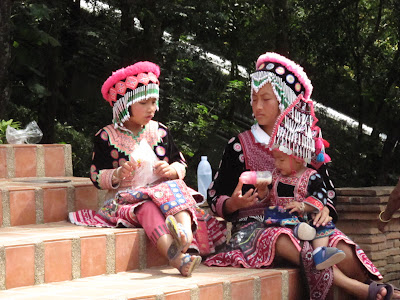Through a little bit of serendipity, we found ourselves headed for Sukhothai on a van with four Spaniards. I had been trying to find the best way to Bangkok and Kanchanaburi, when I asked Korn which was better, a bus or a train or possibly a plane. Quite by accident, I remembered that there were some ruins somewhere between Chiang Mai and Bangkok, but I kept getting mixed up between Sukhothai and Ayutthaya. Both are Unesco World Heritage Sites, and both are ruins of ancient Thai kingdoms, but Ayutthaya is only an hour out of Bangkok, and Sukhothai is farther afield.
“Do you mean Sukhothai?” Korn asked me for probably the fourth time. “And you want to go Tuesday? There is a van of people going to Sukhothai on Tuesday. You can go with them.”
“Are you sure they won’t mind?” I asked.
“It’s fine,” he assured me. Five hundred baht each, roughly $20 each for a four hour van ride.
When Tuesday came, the van departure time kept getting pushed back, which made the Spaniards nervous, but I didn’t care. I’d allotted the day for travel, one day in Sukhothai, and then one more day for travel to Bangkok. We finally left around 11 am, and after leaving the limits of Chiang Mai, we were suddenly in the hinterlands. Most of the drive was just through endless forest and greenery, with small, very poor towns cropping up here and there. Occasionally, we would pass through a somewhat larger town with a little more wealth, but this was clearly Thailand’s poorer rural side.
The Spaniards were loud and emotive, two women and two men, probably in their mid-twenties or so. I didn’t strike up much conversation with them, mostly so I could do blog entries as we drove, but partly because I was tired from Chiang Mai and just needed a break.
We arrived in Sukhothai in late afternoon, a small town, dirty and rough around the edges, with one long main street and a couple of little side streets filled with backpacker joints and street food vendors. Much to the Spaniards’ relief, the van driver dropped them off at a nice-looking guesthouse filled with teak furniture and an open verandah, somewhere behind the scrum of seedy looking hostels. Fifteen minutes later, we pulled up to At Home Sukhothai, our clean but bare bones place with what we later learned was an odd, poorly chosen name.
The proprietor was a lovely woman, probably about my age, who had good but basic English. She showed us our room, a large square area with minimal furniture and decoration, clean but shabby, and interestingly, no tv. It wasn’t that we necessarily wanted a tv. Kinsey and I rarely watched in China, relegated to flipping channels and checking out the Chinese game shows, news, or soap operas, none of which we could understand. Hong Kong and Thailand were a little better, as we could sometimes find an Australian or British channel, although rarely American. No, it was just interesting because it was the first room I could remember where there was no tv at all. Luckily, though, there was free wi-fi.
I asked at the desk whether Loy Krathong was still going on--Chiang Mai had one more day of celebrations--but I was told that Loy Krathong had concluded the night before. With nothing much to do for the rest of the night, we decided to try to find something to eat. We hadn’t eaten much all day, so we headed out for the main road. The street food seemed a bit dicey, hygiene-wise, and there wasn’t much else appealing, when I spotted an ad for KFC.
I hailed a tuk-tuk and asked the driver if he knew KFC. He seemed to get the idea, and told me the price would be 50 baht. This seemed exorbitant to me, so I initially tried to barter, but then gave up and told him I’d pay it. We climbed in.
Tuk-tuks in Sukhothai are the opposite cousins of tuk-tuks in Chiang Mai. In Chiang Mai, a tuk tuk was a three wheeled motorcycle contraption with an enclosed frame around a double seat in back. Tuk-tuks in Sukhothai were still motorcycle contraptions, but here, the passengers rode in front, in a big frame with two benches down the sides. The driver, who sat behind, had to steer the unwieldy load with the handlebars. The ride is both scarier and more thrilling, but dirt keeps flying into your eyes, so I spent the whole trip slightly blinded.
KFC turned out to be quite far away, and we probably saw all of Sukhothai before we got there. It was conveniently located next to a 7-11, another stop I wanted to make, but I realized my problem here--we were just too far away to walk back home. So, I asked the driver to wait for us, promising another 50 baht for the return trip home, while Kinsey and I dashed inside for a take-out meal and a few things from the convenience store.
When we got back into the tuk-tuk, the driver asked us where we were staying, so he could take us right to the hostel.
“At Home,” I replied, and then laughed, realizing what I was saying. I had no map or street name to give him, so I told him to drop us off where he had picked us up. Ten minutes later, we were off the tuk-tuk, the smell of chicken hurrying us home.
Today
9 years ago































































